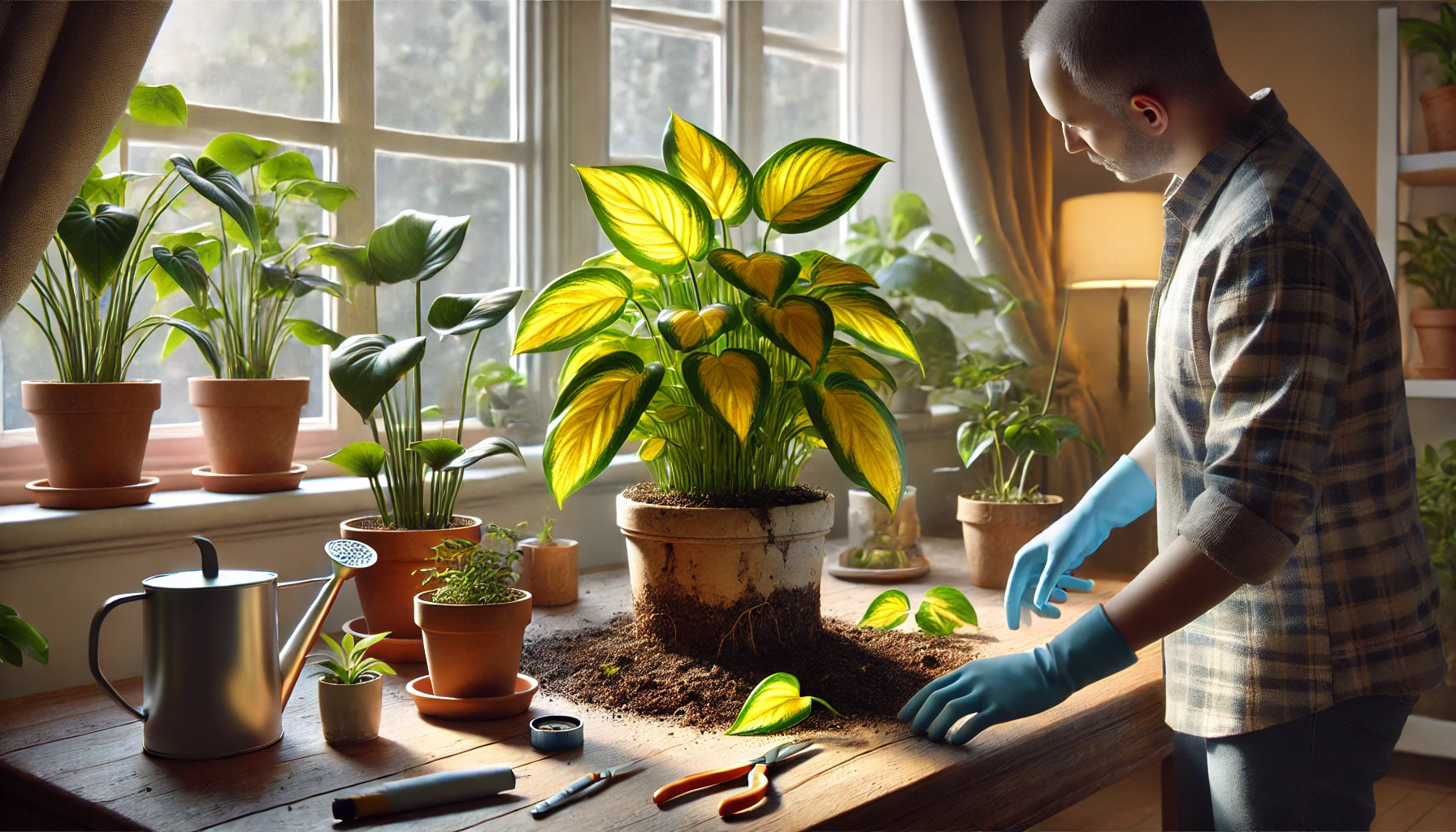You wake up one morning, check your favorite houseplant — and there it is: a yellow leaf. Or worse, several. Before panic sets in, take a deep breath. Yellowing leaves are a common plant problem, and in most cases, it’s your plant’s way of asking for help, not giving up.
This guide will help you understand why leaves turn yellow, how to identify the root cause, and — most importantly — what you can do to bring your plant back to full health.
What Does Yellowing Mean?
Leaf yellowing, also known as chlorosis, happens when a plant’s chlorophyll breaks down. Chlorophyll is the pigment that makes leaves green and powers photosynthesis — the process plants use to convert light into energy.
When leaves turn yellow, it’s usually a sign that:
- Something in the environment is off
- The plant is under stress
- Nutrients or water aren’t being absorbed properly
Let’s look at the most common causes.
1. Overwatering
The #1 culprit behind yellow leaves in houseplants is too much water.
Signs:
- Lower leaves turn yellow first
- Soil feels soggy or smells musty
- Leaves may feel soft or look droopy
- Pot has poor drainage or no holes
Solution:
- Check the soil moisture with your finger or a moisture meter
- Let the soil dry out before watering again
- Repot if the soil is compacted or waterlogged
- Use a well-draining soil mix and a pot with drainage holes
Tip: Only water when the top inch or two of soil is dry — not based on a fixed schedule.
2. Underwatering
Not giving enough water can also cause yellowing, especially in plants that prefer consistent moisture.
Signs:
- Dry, brittle, or crispy leaf edges
- Soil is pulling away from the sides of the pot
- Plant feels lightweight when picked up
- Leaves wilt before turning yellow
Solution:
- Water deeply until it drains from the bottom of the pot
- Check more frequently, especially in warmer months
- Group moisture-loving plants together to retain humidity
Some plants, like ferns or calatheas, are more sensitive to dry conditions.
3. Lack of Light
Plants need light for photosynthesis — without it, they can’t produce enough energy to stay green and vibrant.
Signs:
- Yellowing leaves, especially on the side farthest from the light
- Leggy or stretched stems
- Slow or no growth
Solution:
- Move the plant closer to a window with bright, indirect light
- Rotate the plant weekly for even exposure
- Consider using a grow light in darker rooms
Match the light level to the plant’s natural needs — snake plants tolerate low light, but most others prefer more.
4. Nutrient Deficiency
Yellowing can occur when your plant lacks essential nutrients, especially nitrogen, magnesium, or iron.
Signs:
- Yellowing between leaf veins (known as interveinal chlorosis)
- Overall pale leaves, especially new growth
- Weak or stunted development
Solution:
- Use a balanced, water-soluble fertilizer
- Follow recommended dilution and frequency (usually monthly during growing season)
- Avoid over-fertilizing, which can burn roots and worsen the issue
If unsure, start with a gentle half-strength dose and observe the plant’s response.
5. Temperature Stress
Plants are sensitive to temperature swings and drafts. Both heat and cold stress can trigger yellow leaves.
Signs:
- Yellowing and leaf drop after moving the plant
- Leaf edges turn brown or black
- Plant is near a heater, AC unit, or drafty window
Solution:
- Keep temperatures stable (between 65–75°F / 18–24°C)
- Avoid placing plants near heat sources or cold drafts
- Gradually acclimate plants when changing environments
6. Natural Aging
Sometimes, yellowing is perfectly normal. Older leaves naturally die off as new growth appears.
Signs:
- Yellowing starts on lower leaves
- Rest of the plant looks healthy
- Only one or two leaves affected
Solution:
- Simply trim the yellow leaf with clean scissors
- Continue regular care — no need to change anything
Aging is part of the plant’s life cycle, not a cause for concern.
7. Pests or Disease
Insects like spider mites, aphids, or fungus gnats can cause yellowing through damage or root disruption. Fungal infections can also cause spots or discoloration.
Signs:
- Yellow patches or mottled appearance
- Visible bugs, webbing, or sticky residue
- Soil mold or soft, dark stems
Solution:
- Inspect leaves (top and underside), stems, and soil
- Isolate the plant if pests are found
- Use neem oil, insecticidal soap, or natural remedies
- Remove affected leaves and repot if necessary
What to Do Right Now If You See Yellow Leaves
Here’s a step-by-step approach:
- Check the soil — dry or wet?
- Inspect for light — is the plant getting enough?
- Look for pests — especially under the leaves
- Assess recent changes — new spot, season, or watering routine?
- Trim the yellow leaf — it won’t turn green again
- Adjust care — based on what you discover
Most of the time, you can save the plant by acting early.
When to Repot
If yellowing persists and the plant seems unhappy despite your care, it might be rootbound or stuck in poor soil.
Repot if:
- Roots are circling the bottom or poking through the drainage hole
- Soil stays wet for too long or drains poorly
- You haven’t repotted in over 1–2 years
Choose a slightly larger pot, refresh the soil, and inspect the roots while you’re at it.
Final Thoughts: Don’t Panic — Observe
A yellow leaf doesn’t mean failure — it means feedback. Plants are incredibly responsive and forgiving once their needs are met.
By learning to observe, diagnose, and respond, you’ll not only save your plant but also become a more confident, intuitive plant parent.
So the next time a leaf goes yellow, see it as an invitation to connect — not a reason to quit.
